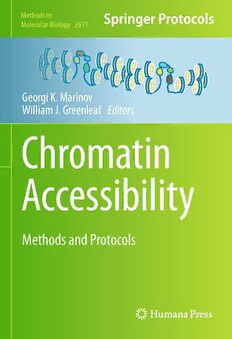Table Of ContentMethods in
Molecular Biology 2611
Georgi K. Marinov
William J. Greenleaf Editors
Chromatin
Accessibility
Methods and Protocols
M M B
ETHODS IN OLECULAR IO LO GY
SeriesEditor
JohnM.Walker
School of Lifeand MedicalSciences
University ofHertfordshire
Hatfield, Hertfordshire, UK
Forfurther volumes:
http://www.springer.com/series/7651
For over 35 years, biological scientists have come to rely on the research protocols and
methodologiesinthecriticallyacclaimedMethodsinMolecularBiologyseries.Theserieswas
thefirsttointroducethestep-by-stepprotocolsapproachthathasbecomethestandardinall
biomedicalprotocolpublishing.Eachprotocolisprovidedinreadily-reproduciblestep-by-
step fashion, opening with an introductory overview, a list of the materials and reagents
neededtocompletetheexperiment,andfollowedbyadetailedprocedurethatissupported
with a helpful notes section offering tips and tricks of the trade as well as troubleshooting
advice. These hallmark features were introduced by series editor Dr. John Walker and
constitutethekeyingredientineachandeveryvolumeoftheMethodsinMolecularBiology
series. Tested and trusted, comprehensive and reliable, all protocols from the series are
indexedinPubMed.
Chromatin Accessibility
Methods and Protocols
Edited by
Georgi K. Marinov and William J. Greenleaf
Stanford University, Stanford, CA, USA
Editors
GeorgiK.Marinov WilliamJ.Greenleaf
StanfordUniversity StanfordUniversity
Stanford,CA,USA Stanford,CA,USA
ISSN1064-3745 ISSN1940-6029 (electronic)
MethodsinMolecularBiology
ISBN978-1-0716-2898-0 ISBN978-1-0716-2899-7 (eBook)
https://doi.org/10.1007/978-1-0716-2899-7
©TheEditor(s)(ifapplicable)andTheAuthor(s),underexclusivelicensetoSpringerScience+BusinessMedia,LLC,part
ofSpringerNature2023
Chapter 6 is licensed under the terms of the Creative Commons Attribution 4.0 International License (http://
creativecommons.org/licenses/by/4.0/).Forfurtherdetailsseelicenseinformationinthechapter.
Thisworkissubjecttocopyright.AllrightsaresolelyandexclusivelylicensedbythePublisher,whetherthewholeorpart
of the material is concerned, specifically the rights of translation, reprinting, reuse of illustrations, recitation,
broadcasting,reproductionon microfilmsorinanyotherphysicalway,andtransmissionorinformation storageand
retrieval,electronicadaptation, computersoftware,orbysimilar ordissimilar methodologynow knownorhereafter
developed.
Theuseofgeneraldescriptivenames,registerednames,trademarks,servicemarks,etc.inthispublicationdoesnotimply,
evenintheabsenceofaspecificstatement,thatsuchnamesareexemptfromtherelevantprotectivelawsandregulations
andthereforefreeforgeneraluse.
Thepublisher,theauthors,andtheeditorsaresafetoassumethattheadviceandinformationinthisbookarebelievedto
betrueandaccurateatthedateofpublication.Neitherthepublishernortheauthorsortheeditorsgiveawarranty,
expressedorimplied,withrespecttothematerialcontainedhereinorforanyerrorsoromissionsthatmayhavebeen
made.Thepublisherremainsneutralwithregardtojurisdictionalclaimsinpublishedmapsandinstitutionalaffiliations.
ThisHumanaimprintispublishedbytheregisteredcompanySpringerScience+BusinessMedia,LLC,partofSpringer
Nature.
Theregisteredcompanyaddressis:1NewYorkPlaza,NewYork,NY10004,U.S.A.
Preface
The genomic distribution patterns of chromatin accessibility and its dynamics are key
featuresoftheregulationofgeneexpressionandmanyotheraspectsofchromatinbiology.
The genomes of eukaryotes are usually packaged by nucleosomal particles, which have a
generally strong inhibitory effect on transcription and on the occupancy of DNA by
regulatory proteins. It is typically active cis-regulatory regions (cREs) in the genome that
arecharacterizedbydepletednucleosomaloccupancyandincreasedchromatinaccessibility,
which has in turn proven to be a highly useful property enabling the identification of
candidate cREs as well as the tracking of their activity across cell types and conditions as
accessibleDNAcanbepreferentiallyenzymaticallyorchemicallylabeledinnumerousways.
Technological advances in the labeling and readout of accessible DNA have played a
major roleindrivingforwardour understandingofchromatinandregulatorybiologyover
the last few decades. The last 15 years have seen a particularly dramatic explosion in the
varietyandpowerofapproachesforstudyingchromatinaccessibility,drivenbytwosequen-
tialtechnologicalrevolutions:first,thedevelopmentofhigh-throughputsequencinginthe
mid-2000s,andthentheadventofsingle-cellgenomicsinthe2010s.Thecurrentbookaims
to provide a comprehensive resource covering the existing and state-of-the-art tools in the
field.
We have divided the protocols in the book into several sections, depending on the
different aspects of chromatin accessibility that they measure and/or approaches that they
take.Inthefirstsection,bulk-cellmethodsforprofilingchromatinaccessibilityandnucleo-
somepositioningthatrelyonenzymaticcleavageofaccessibleDNAandproduceinforma-
tionaboutrelativeaccessibilityarecovered.Thesecondsectionisdedicatedtomethodsthat
usesingle-moleculeandenzymaticapproachestosolvingtheproblemofmappingabsolute
occupancy/accessibility. The third section covers the wide array of emerging tools for
mappingDNAaccessibilityandnucleosomepositioning insingle cells,aswellasanumber
of single-cell multiomics methods that simultaneously measure chromatin accessibility and
other features of the cell, such as the transcriptome, the methylome, and protein markers.
More recently, imaging-based methods for visualizing accessible chromatin in its nuclear
context have emerged; these are included in the fourth section. The final section features
computational methods for the processing and analysis of chromatin accessibility datasets.
This book will serve as an extensive and useful reference for researchers studying different
facetsofchromatinaccessibilityinawidevarietyofbiologicalcontexts.
Stanford,CA,USA GeorgiK.Marinov
WilliamJ.Greenleaf
v
Contents
Preface ..................................................................... v
Contributors................................................................. ix
PART I BULK CLEAVAGE-BASED METHODS
1 Genome-WideMappingofActiveRegulatoryElementsUsing
ATAC-seq.......... ....... ........ ....... ....... ........ ....... ........ 3
GeorgiK.Marinov,ZoharShipony,AnshulKundaje,
andWilliamJ.Greenleaf
2 MappingNucleosomeLocationUsingFS-Seq....... ........ ....... ........ 21
BarryMilavetz,BrennaHanson,KincaidRowbotham,
andJacobHaugen
3 UniversalNicE-Seq:ASimpleandQuickMethodforAccessible
ChromatinDetectioninFixedCells......... ....... ........ ....... ...... .. 39
HangGyeongChin,UdayakumarS.Vishnu,ZhiyiSun,
V.K.ChaithanyaPonnaluri,GuoqiangZhang,Shuang-yongXu,
TouatiBenoukraf,PalomaCejas,GeorgeSpracklin,
Pierre-OlivierEste`ve,HenryW.Long,andSriharsaPradhan
4 MeasuringInaccessibleChromatinGenome-WideUsingProtect-seq ......... 53
GeorgeSpracklin,LiyanYang,SriharsaPradhan,andJobDekker
5 DeterminationoftheChromatinOpennessinBacterialGenomes..... ........ 63
MahmoudM.Al-BassamandKarstenZengler
6 ProfilingChromatinAccessibilityonReplicatedDNAwith
repli-ATAC-Seq..... ....... ........ ....... ....... ........ ....... ........ 71
KathleenR.Stewart-MorganandAnjaGroth
7 AnalysisofChromatinInteractionandAccessibilitybyTrac-Looping.......... 85
ShuaiLiu,QingsongTang,andKejiZhao
PART II METHODS FOR MEASURING THE ABSOLUTE
LEVELS OF OCCUPANCY/ACCESSIBILITY
8 Single-MoleculeMappingofChromatinAccessibilityUsing
NOMe-seq/dSMF...... ... ........ ....... ....... ........ ....... ........ 101
MichaelaHinks,GeorgiK.Marinov,AnshulKundaje,
LacramioaraBintu,andWilliamJ.Greenleaf
9 ORE-Seq:Genome-WideAbsoluteOccupancyMeasurement
byRestrictionEnzymeAccessibilities........ ....... ........ ....... ........ 121
ElisaOberbeckmann,MichaelRolandWolff,NilsKrietenstein,
MarkHeron,AndreaSchmid,TobiasStraub,UlrichGerland,
andPhilippKorber
vii
viii Contents
PART III METHODS FOR PROFILING CHROMATIN ACCESSIBILITY
AT THE SINGLE-CELL LEVEL
10 Single-CellJointProfilingofOpenChromatinandTranscriptome
byPaired-Seq ...... ....... ........ ....... ....... ........ ....... ........ 155
ChenxuZhu,ZhaoningWang,andBingRen
11 SimultaneousSingle-CellProfilingoftheTranscriptomeand
AccessibleChromatinUsingSHARE-seq.... ....... ........ ....... ........ 187
SamuelH.Kim,GeorgiK.Marinov,S.TansuBagdatli,SoonIlHigashino,
ZoharShipony,AnshulKundaje,andWilliamJ.Greenleaf
12 SimultaneousMeasurementofDNAMethylationandNucleosome
OccupancyinSingleCellsUsingscNOMe-Seq...... ........ ....... .... .... 231
MichaelWasneyandSebastianPott
13 MassivelyParallelProfilingofAccessibleChromatinandProteins
withASAP-Seq..... ....... ........ ....... ....... ........ ....... ........ 249
EleniMimitou,PeterSmibert,andCalebA.Lareau
14 ConcomitantSequencingofAccessibleChromatinandMitochondrial
GenomesinSingleCellsUsingmtscATAC-Seq...... ........ ....... ........ 269
LeifS.LudwigandCalebA.Lareau
PART IV IMAGING METHODS FOR VISUALIZATION OF ACCESSIBLE DNA
15 ATAC-See:ATn5Transposase-MediatedAssayforDetectionof
ChromatinAccessibilitywithImaging....... ....... ........ ... .... ..... ... 285
YonglongDang,RamPrakashYadav,andXingqiChen
16 NicE-viewSeq:AnIntegrativeVisualizationandGenomicsMethod
toDetectAccessibleChromatininFixedCells....... ........ ....... ........ 293
Pierre-OlivierEste`ve,UdayakumarS.Vishnu,
HangGyeongChin,andSriharsaPradhan
PART V COMPUTATIONAL ANALYSIS OF CHROMATIN ACCESSIBILITY DATASETS
17 ATAC-seqDataProcessing.......... ....... ....... ........ ....... ........ 305
DanielS.Kim
18 DeepLearningonChromatinAccessibility.......... ........ ....... ... ..... 325
DanielS.Kim
Index .......... ........ ....... ........ ....... ....... ........ ....... ........ 335
Contributors
MAHMOUDM.AL-BASSAM • DepartmentofPediatrics,UniversityofCalifornia,SanDiego,
LaJolla,CA,USA
S.TANSU BAGDATLI • DepartmentofGenetics,StanfordUniversity,Stanford,CA,USA
TOUATIBENOUKRAF • FacultyofMedicine,CraigL.DobbinGeneticsResearchCentre,
MemorialUniversityofNewfoundland,St.John’s,NL,Canada
LACRAMIOARABINTU • DepartmentofBioengineering,StanfordUniversity,Stanford,CA,
USA
PALOMA CEJAS • Center forFunctionalCancerEpigenetics,Dana-FarberCancerInstitute,
Boston,MA,USA
XINGQI CHEN • DepartmentofImmunology,GeneticsandPathology,UppsalaUniversity,
Uppsala,Sweden
HANGGYEONGCHIN • NewEnglandBiolabsInc.,Ipswich,MA,USA;GenomeBiology
Division,NewEnglandBiolabs,Inc.,Ipswich,MA,USA
YONGLONGDANG • DepartmentofImmunology,GeneticsandPathology,Uppsala
University,Uppsala,Sweden
JOBDEKKER • PrograminSystemsBiology,UniversityofMassachusettsMedicalSchool,
Worcester,MA,USA;HowardHughesMedicalInstitute,Boston,MA,USA
PIERRE-OLIVIER ESTE`VE • NewEnglandBiolabsInc.,Ipswich,MA,USA;GenomeBiology
Division,NewEnglandBiolabs,Inc.,Ipswich,MA,USA
ULRICHGERLAND • DepartmentofPhysics,TechnicalUniversityofMunich,Garching,
Germany
WILLIAMJ.GREENLEAF • DepartmentofGenetics,StanfordUniversity,Stanford,CA,USA;
Center forPersonalDynamicRegulomes,StanfordUniversity,Stanford,CA,USA;
DepartmentofAppliedPhysics,StanfordUniversity,Stanford,CA,USA;ChanZuckerberg
Biohub,SanFrancisco,CA,USA
ANJAGROTH • NovoNordiskFoundationCenter forProteinResearch(CPR),Facultyof
HealthandMedicalSciences,UniversityofCopenhagen,Copenhagen,Denmark;Biotech
ResearchandInnovationCentre(BRIC),FacultyofHealthandMedicalSciences,
UniversityofCopenhagen,Copenhagen,Denmark
BRENNA HANSON • DepartmentofBiomedicalSciences,SchoolofMedicine,Universityof
NorthDakota,GrandForks,ND,USA
JACOBHAUGEN • DepartmentofBiomedicalSciences,SchoolofMedicine,UniversityofNorth
Dakota,GrandForks,ND,USA
MARKHERON • QuantitativeandComputationalBiology,MaxPlanckInstitutefor
BiophysicalChemistry,Go¨ttingen,Germany;GeneCenter,FacultyofChemistryand
Pharmacy,Ludwig-Maximilians-Universita€tMu¨nchen,Munich,Germany
SOONILHIGASHINO • DepartmentofGenetics,StanfordUniversity,Stanford,CA,USA
MICHAELAHINKS • DepartmentofGenetics,StanfordUniversity,Stanford,CA,USA
DANIELS.KIM • BiomedicalInformaticsProgram,StanfordUniversitySchoolofMedicine,
Stanford,CA,USA
SAMUELH.KIM • CancerBiologyProgram,SchoolofMedicine,StanfordUniversity,
Stanford,CA,USA;MedicalScientistTrainingProgram,StanfordUniversity,Stanford,
CA,USA
ix
x Contributors
PHILIPPKORBER • BiomedicalCenter(BMC),DivisionofMolecularBiology,Facultyof
Medicine,LMUMunich,Martinsried,Germany
NILSKRIETENSTEIN • NovoNordiskFoundationCenter forProteinResearch,Universityof
Copenhagen,Copenhagen,Denmark
ANSHULKUNDAJE • DepartmentofGenetics,StanfordUniversity,Stanford,CA,USA;
DepartmentofComputerScience,StanfordUniversity,Stanford,CA,USA
CALEB A.LAREAU • DepartmentsofGeneticsandPathology,StanfordUniversity,Stanford,
CA,USA
SHUAILIU • LaboratoryofEpigenomeBiology,SystemsBiologyCenter,Divisionof
IntramuralResearch,NationalHeart,LungandBloodInstitute,NationalInstitutesof
Health,Bethesda,MD,USA
HENRYW.LONG • Center forFunctionalCancerEpigenetics,Dana-FarberCancer
Institute,Boston,MA,USA
LEIF S.LUDWIG • BerlinInstituteofHealthatCharite´Universita€tsmedizinBerlin,Berlin,
Germany;Max-Delbru¨ck-Center forMolecularMedicineintheHelmholtzAssociation,
BerlinInstituteforMedicalSystemsBiology,Berlin,Germany
GEORGIK.MARINOV • DepartmentofGenetics,StanfordUniversity,Stanford,CA,USA
BARRYMILAVETZ • DepartmentofBiomedicalSciences,SchoolofMedicine,Universityof
NorthDakota,GrandForks,ND,USA
ELENI MIMITOU • Immunai,NewYork,NY,USA
ELISAOBERBECKMANN • DepartmentofMolecularBiology,MaxPlanckInstitutefor
MultidisciplinarySciences,Go¨ttingen,Germany
V.K.CHAITHANYAPONNALURI • NewEnglandBiolabsInc.,Ipswich,MA,USA
SEBASTIANPOTT • UniversityofChicago,Chicago,IL,USA
SRIHARSAPRADHAN • NewEnglandBiolabsInc.,Ipswich,MA,USA;GenomeBiology
Division,NewEnglandBiolabs,Inc.,Ipswich,MA,USA
BING REN • LudwigInstituteforCancerResearch,LaJolla,CA,USA;Departmentof
CellularandMolecularMedicine,UniversityofCaliforniaSanDiego,SchoolofMedicine,
LaJolla,CA,USA;CenterforEpigenomics,InstituteofGenomicMedicine,MooresCancer
Center,UniversityofCaliforniaSanDiego,SchoolofMedicine,LaJolla,California,USA
KINCAIDROWBOTHAM • DepartmentofBiomedicalSciences,SchoolofMedicine,Universityof
NorthDakota,GrandForks,ND,USA
ANDREA SCHMID • BiomedicalCenter(BMC),DivisionofMolecularBiology,Facultyof
Medicine,LMUMunich,Martinsried,Germany
ZOHARSHIPONY • DepartmentofGenetics,StanfordUniversity,Stanford,CA,USA
PETERSMIBERT • 10xGenomics,Pleasanton,CA,USA
GEORGESPRACKLIN • PrograminSystemsBiology,UniversityofMassachusettsMedicalSchool,
Worcester,MA,USA
KATHLEENR.STEWART-MORGAN • NovoNordiskFoundationCenter forProteinResearch
(CPR),FacultyofHealthandMedicalSciences,UniversityofCopenhagen,Copenhagen,
Denmark;BiotechResearchandInnovationCentre(BRIC),FacultyofHealthand
MedicalSciences,UniversityofCopenhagen,Copenhagen,Denmark
TOBIASSTRAUB • CoreFacilityBioinformatics,BiomedicalCenter(BMC),Facultyof
Medicine,LMUMunich,Martinsried,Germany
ZHIYISUN • NewEnglandBiolabsInc.,Ipswich,MA,USA
QINGSONGTANG • LaboratoryofEpigenomeBiology,SystemsBiologyCenter,Divisionof
IntramuralResearch,NationalHeart,LungandBloodInstitute,NationalInstitutesof
Health,Bethesda,MD,USA

